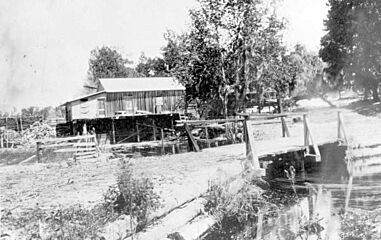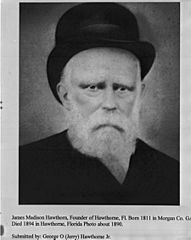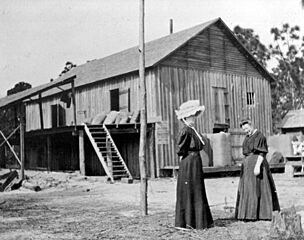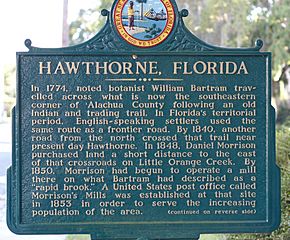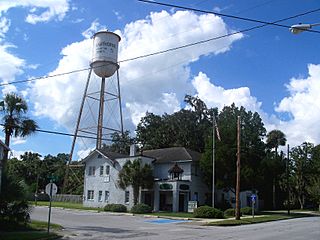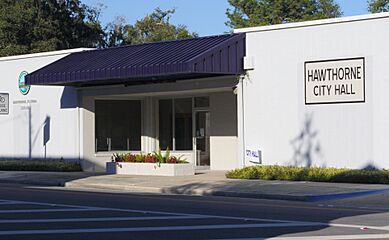Hawthorne, Florida facts for kids
Quick facts for kids
Hawthorne, Florida
|
|
|---|---|
| City of Hawthorne | |

Location in Alachua County and the state of Florida
|
|
| Country | |
| State | |
| County | Alachua |
| Settled (Waits Crossing-Jamestown) | c. 1853-Late 1870s |
| Incorporated (City of Hawthorn) |
June 23, 1881 |
| Incorporated (City of Hawthorne) |
1950 |
| Government | |
| • Type | Commission–Manager |
| Area | |
| • Total | 7.64 sq mi (19.79 km2) |
| • Land | 7.38 sq mi (19.11 km2) |
| • Water | 0.26 sq mi (0.68 km2) |
| Elevation | 148 ft (45 m) |
| Population
(2020)
|
|
| • Total | 1,478 |
| • Density | 200.27/sq mi (77.33/km2) |
| Time zone | UTC-5 (Eastern (EST)) |
| • Summer (DST) | UTC-4 (EDT) |
| ZIP code |
32640
|
| Area code(s) | 352 |
| FIPS code | 12-29275 |
| GNIS feature ID | 0283829 |
Hawthorne (![]() i/ˈhɔːθoʊrn/) is a city in Alachua County, Florida, United States. It was officially made a city in 1881. Long before that, Native Americans lived in the area, starting around 100 CE. Hawthorne grew up around their old trading paths.
i/ˈhɔːθoʊrn/) is a city in Alachua County, Florida, United States. It was officially made a city in 1881. Long before that, Native Americans lived in the area, starting around 100 CE. Hawthorne grew up around their old trading paths.
Throughout its history, Hawthorne has been known for its farms, its railroad connections, and its quiet, country way of life. In 2020, about 1,478 people lived in Hawthorne. The city covers an area of about 7.38 square miles (19.11 km²). It is part of the larger Gainesville area.
Contents
Hawthorne's History
Early Native American Life
People have lived in the Hawthorne area for a very long time. Around 100 to 600 CE, the Cades Pond culture built a mound near the city. Later, from 600 to 1700 CE, the Alachua culture had a campsite in Hawthorne. They left behind pottery and stone tools.
When the Spanish arrived in the 1500s, Timucua-speaking natives lived in North Florida. The Hawthorne area was important because it was on an "old Indian and trading trail." This trail connected different native groups and later, early settlers.
Settlement and Growth
By 1837, a road connected Micanopy and Palatka through the Hawthorne area. In the 1840s, a mill was built on Little Orange Creek. This led to the founding of Pleasant Grove Baptist Church and a post office in 1854. The first school opened in 1869 in a log cabin.
In the late 1870s, a valuable mineral called Phosphate was found near Hawthorne. The area was first known as Jamestown, named after James M. Hawthorn. Another area, Waits Crossing, was planned in 1881. These new areas helped bring railroads to the town.
The Railroad Era
Railroad tracks first reached Hawthorne in 1879. The Peninsula Railroad built a line going north and south. Around the same time, the Florida Southern Railroad built a line going east and west. This made Hawthorne a very important place where two major rail lines crossed.
Each railroad company had its own station, about half a mile apart. A post office named Hawthorn opened in 1880. The spelling was changed to Hawthorne in 1950.
On June 23, 1881, Hawthorne officially became a city. The Florida Southern Railroad sold land in Hawthorne, describing it as a great place for growing vegetables. Hawthorne also became known for hunting and fishing. People from the North would visit to enjoy these activities. They could stay at William Shepard Moore's hotel, which offered guides and horses for hunting.
Changes in Farming and Industry
In the 1880s, many orange groves were planted. But a big freeze in 1894 destroyed the citrus trees. Farmers then started growing vegetables and Sea Island cotton. However, a tiny insect called the boll weevil later ruined the cotton crops.
Hawthorne then started other businesses. These included making bricks, producing turpentine from pine trees, and more railroad work. Because two rail lines crossed here, it was a busy transfer point. In 1912, the railroad companies had to build a shared passenger station. By 1913, Hawthorne was a lively town with many stores, hotels, and a bank.
Modern Times
Hawthorne grew a lot in the 1920s. It had a bank, a high school, and plants for ice and electricity. Even during the Great Depression, daily train service continued. A new highway, Highway 20, was paved, and a bridge was built over the railroad tracks. The area remained a farming center.
The original city hall burned down in the 1930s. A new one was built and used until 2018. The city hall then moved to an old bank building. The old city hall became a community center.
After World War II, farming declined because the land was tired. The pulpwood industry began, with companies buying large areas of land for trees. A state forest was also created nearby. Hawthorne remained a place for hunting and fishing. Little growth happened in the 1950s and 1960s. The city was known for its lima beans. The turpentine industry ended in the late 1950s. In the early 1960s, US 301 was built, bypassing downtown Hawthorne.
Growth picked up a bit in the 1970s. As cars became more popular, passenger trains and buses stopped serving the city. Many people started traveling to Gainesville for work. In the 1980s, people began to appreciate Hawthorne's quiet, country lifestyle. Local jobs still existed in sand mines, chicken farms, and plywood mills. Since the 1980s, Hawthorne's population has not grown much. In 2015, the city added about 1,300 acres of land.
Hawthorne's Location and Weather
Where is Hawthorne?
Hawthorne is in North Central Florida. It is located at 29°35′17″N 82°5′2″W / 29.58806°N 82.08389°W. The city is on the eastern edge of Alachua County. Part of the city is right next to the border with Putnam County. It is about 17 miles (27 km) east of Gainesville, which is the biggest city in Alachua County. The city covers about 6.8 square miles (17.6 km²) of land and 0.26 square miles (0.67 km²) of water.
Hawthorne's Climate
Hawthorne has a humid subtropical climate. This means it has hot, humid summers. The winters are generally mild.
People of Hawthorne
| Historical population | |||
|---|---|---|---|
| Census | Pop. | %± | |
| 1900 | 296 | — | |
| 1910 | 324 | 9.5% | |
| 1920 | 543 | 67.6% | |
| 1930 | 600 | 10.5% | |
| 1940 | 741 | 23.5% | |
| 1950 | 1,058 | 42.8% | |
| 1960 | 1,167 | 10.3% | |
| 1970 | 1,126 | −3.5% | |
| 1980 | 1,303 | 15.7% | |
| 1990 | 1,305 | 0.2% | |
| 2000 | 1,415 | 8.4% | |
| 2010 | 1,417 | 0.1% | |
| 2020 | 1,478 | 4.3% | |
| U.S. Decennial Census | |||
In 2020, there were 1,478 people living in Hawthorne. There were 472 households and 292 families.
Many different people live in Hawthorne. In 2020, about 38.5% of the people were White. About 49.9% were Black or African American. Other groups included Native American, Asian, and people of two or more races. About 4.7% of the people were Hispanic or Latino.
The average income for a household in Hawthorne was $37,500. About 29% of the people lived below the poverty line. This included about 34.8% of children under 18.
How Hawthorne is Governed
Hawthorne has a special type of government called a commission–manager system. The city is run by a city commission, which has five commissioners, a mayor, and a vice-mayor. A city manager is in charge of running all the city's daily business. The current mayor of Hawthorne is Jacquelyn Randall, who started in 2021.
Fun Things to Do in Hawthorne
Parks and Nature Areas
Hawthorne has some great places to enjoy nature. In 2011, the city got about 3,000 acres (1,200 ha) around Little Orange Creek. The Little Orange Creek Nature Park opened in 2017. It has two parts. One part is a nature park with parking and a center for learning about the environment. The other part is a large conservation area for plants and animals. This area has public trails for hiking, biking, and horseback riding.
The city also has Lindsey Phillips Park, located on Johnson Lake. This park has a boat ramp, a fishing pier, a playground, and picnic areas.
South and west of Hawthorne are several large nature areas. The Lochloosa Wildlife Management Area is over 11,000 acres (4,500 ha). It is part of the Great Florida Birding and Wildlife Trail. Here, you can hike, bike, ride horses, hunt, fish, canoe, and boat.
Historic Sites Nearby
The Marjorie Kinnan Rawlings Historic State Park is about 14 miles (23 km) southwest of Hawthorne. This park protects the old home where author Rawlings lived and wrote her famous books. Even though she didn't live in Hawthorne, she used the Hawthorne post office.
Sports and Recreation
Hawthorne has its own Athletic Park. It has four fields for baseball and softball, a multi-purpose field, a playground, and picnic areas. A group called Hawthorne Youth Sports offers many sports for kids, like baseball, softball, football, soccer, basketball, and cheerleading.
The Hawthorne Hornets football team plays at Hawthorne High School. Their coach is Cornelius Ingram, a former NFL player. In 2018, the city opened a wellness center next to the Athletic Park. Many older people in the community use this gym.
City Services
Getting Around
Hawthorne is located where two main roads meet: US Highway 301 and Florida State Road 20.
CSX Transportation owns the north-south train tracks that run through Hawthorne. These tracks are used for freight trains. The old railroad station from 1912 is now used as a business.
The Gainesville-Hawthorne State Trail is a 16-mile (26 km) paved path that connects Gainesville to Hawthorne. It goes through beautiful nature areas with wetlands and pine forests. You can use it for walking, cycling, and horseback riding. This trail was made from an old, unused railroad line.
Utilities and Safety
The city's Department of Public Works handles trash pickup, recycling, clean water, and sewer services. Electricity is provided by Florida Power & Light and Clay Electric Cooperative.
For safety, the Alachua County Sheriff's Office provides law enforcement. Emergency services, like fire and rescue, are handled by Alachua County Fire Rescue. In 2015, their Station 25 in Hawthorne moved into a newly fixed-up building. This station has a fire engine, an ambulance, and other important vehicles.
Schools and Libraries
Hawthorne's schools are part of the Alachua County Public Schools system. These include Shell Elementary School and Hawthorne Middle/High School. The Alachua County Library District also has a library branch in the city. Shell Elementary School was named after Chester Shell, who worked hard to open a school for Black children in Hawthorne. This school opened in 1922 as Hawthorne High School.
Media and News
In Hawthorne, you can watch TV stations like WUFT PBS, WOGX Fox, WCJB-TV ABC, WGFL CBS, and WYME-CD MeTV. There are also many radio stations nearby. Local newspapers include The Gainesville Sun, The Independent Florida Alligator, and Alachua County Today.
Famous People from Hawthorne
- Bo Diddley, a famous musician
- James B. Edwards, a former Governor of South Carolina
- Cornelius Ingram, a former NFL football player
- D. R. "Billy" Matthews, a Congressman
See also
 In Spanish: Hawthorne (Florida) para niños
In Spanish: Hawthorne (Florida) para niños


